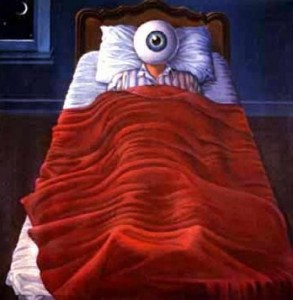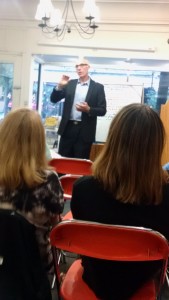
Tag Archives: anxiety
Waking up at three in the morning and not being able to fall back asleep is rough. Going to bed at 11 pm, but not falling asleep till 1:30 am is equally wicked. Let’s look first at the biochemistry of sleeplessness, and then explore two techniques useful in putting yourself into sleep. 
By and large, it’s a chemical reaction that keeps us awake–one instigated by our thoughts and feelings. The trick then, is creating a different chemical reaction, requiring different thoughts and feelings.
Here’s what I mean. More often than not, when we can’t fall asleep, our minds are chewing on some thought. But by the nature of that thought, we begin to feel more and more anxious, nervous or scared. It’s those uncomfortable feelings that begin the biochemical process. Essentially, those scary thoughts, that then make us anxious, produce a fight or flight reaction in the body. Literally, when in a fight or flight reaction, the body pumps hormones through us that ready us for action. You know those chemicals are coursing through you when you start twisting and turning. The chemicals are trying to activate you so you can protect yourself. That’s because the scary thoughts and feelings are telling the body it needs to protect itself. Great when chased by a dog. Not great when wanting sleep.
When trying to sleep, we want chemicals or hormones released by our bodies that encourage relaxation. But if our minds are chomping on scary thoughts the body is incapable of those relaxation hormones.
This is where the techniques come into play. Both techniques below offer replacement thoughts that produce more comforting feelings, that then encourage the body to release more relaxing chemicals. The techniques are called The Golden View and The Compassionate Heart.
Let’s start with The Golden View exercise:
Step 1. Recognize that your mind is racing
Step 2. Imagine an ideal or Golden solution to the fearful situation your mind is stuck on
Step 3. As your mind pulls to return you to the fearful thinking and feeling, gently continue to fill in all the details of your Golden View of the future as your ideal solution unfolds.
Now a look at The Compassionate Heart exercise:
Step 1. Recognize that your mind is racing or uncomfortable
Step 2. Call to mind someone you know who’s struggling or in some kind of pain
Step 3. As you inhale, compassionately see that person, and as you exhale, send them love and trust
Science is pretty clear on this one: love brings healing and wholeness. Fear, anger and doubt bring compromised immune function and unhappiness. So for your sake, why not add more love to your life in the New Year? 
We know from lots of studies that living in a state of peace and love and happiness strengthens our body’s ability to fight disease. The research is so consistent and prolific that most accept it now as common knowledge.
But we forget. We get politically fired up, or fired up on a basketball court, or fired up at a co-worker or neighbor. This is where the research can be a bit tricky to understand.
Research seems to suggest that getting “fired up” or angry isn’t a bad thing. However, if we blow a gasket on a daily basis, or if we hold our anger in and act like everything’s great all the time, then our bodies can pay the price. So it’s not anger itself that’s bad for us. It’s explosive or suppressed anger that will cause physical problems.
Same for sadness and fear. We all have regular occasion to be sad or scared or doubtful. These emotions are part of life. Problems arise, though, when we completely avoid these more difficult emotions, or when we get stuck feeling one for long periods.
Sure, there are times in all our lives when we seem to get angry a lot, or we just can’t shake the blues. But the healthier we get, the less fear, anger, doubt and sadness linger.
All emotions deserve a place at the table. Just make sure it’s you sitting at the head.
With practice, each of us is capable of naming individual emotions as they rise up. And mastery comes when we see each emotion simply as a wave that has splashed up from the ocean of our minds. We remain in peace as each feeling crashes the surface of our thoughts, knowing that soon it will return to the deep and quiet ocean it came from.
Our job is to watch these emotion waves rather than become them. When we become each individual wave or emotion, we can get tossed about. However, when we simply watch each wave, we stay calm like the ocean deep; like the deep waters of the still mind.
When we practice this emotional witnessing, we return more quickly to the peace and love always available to us and in us.
So to help add a little love to your New Year, consider trying one or two of these:
- Put your hand on your heart, and feel your own heart beat.
- Feel your lover’s heart beat.
- Make a donation.
- Get a massage.
- Give one.
- Send a card to someone who could really use it.
- Build something; bake something.
- Commit to doing something special next week that you really enjoy.
- Laugh hard.
- Sing.
- Let someone love you in a very specific way.
- Say, “I love you,” with conviction.
- Send loving thoughts to someone you don’t understand.
Here’s to more love, peace and joy in 2016.
Had an article all queued up two weeks ago for this last Thursday in 2015: all about the uselessness of worry. Then life served up a chance to practice what I was preaching.
St. Louis saw record rainfall earlier in the week. This photo is my front yard on Monday. On Sunday, the lake my home sits on breached its containment, and the watch ensued. Levels held pretty steady until about 3 a.m., and from there the water steadily rose. 
By 10 a.m. on Monday morning, the lake seemed close to crest, still needing another foot plus to reach my basement. Feeling pretty confident that my neighbors and I had bested the worst of the storm, I went downstairs to exercise a bit.
Well, well, well. What have we here? When I reached the bottom of the steps, the carpet splashed. So even though the water hadn’t reached the exterior level of my basement, the sewer system supporting these low-lying homes couldn’t handle all the water, and it was tumbling up out of my basement drain.
Pretty sure there was one f-bomb, then to work. First I put soup cans somebody gave me under the legs of a table I’d made, and put my drum kit on top of that. Next was the P.A. system up the steps. Then albums and all sorts of stuff where stacked on metal chairs. Lastly, boxes of CD’s and books were taken upstairs.
Eventually, the drain started acting right, and water went back underground. I used a sheet of plywood like a big ole’ squeegee, and pushed water to the drain. Thankfully, the basement is not finished, so only the carpet at the bottom of the stairs was soaked. In time, I hosed down the little sewage that came up, hit the carpet with a shop vac, dried the whole thing with fan and heater and lastly did some disinfecting.
Who knew life was gonna offer up an occasion to experience myself in higher stress. And while my mind wanted to spin scary stories, it didn’t. And that was the whole point of the original article about the uselessness of worry. Unless we’re being chased by a dog or somehow seriously threatened, worry is useless.
Worry cops our energy. It weakens our focus. It steals oxygen from the brain, making clear communication and thinking difficult.
So why do it? Worry can be companion to a mind hooked on overactivity. Worry can give a place for anxious energy to land. Worry can also give us a a sense of self, albeit a broken one. When you think about it, worry begins to sound somewhat self-involved.
So if you care to, please join me in leaving any habit of worry in 2015.
Here’s a three step process to help:
Step 1. Get familiar with your worry. Notice when it’s beginning and ending. Your body can help with its Stress Activated Signals (S.A.S.). These signals include things like ears getting hot, tightness in chest, sweaty palms, choppy sentences and stomach upset.
Step 2. Recognize in this moment of worry, you have the following choices: fight the situation, get away from it, freeze with fear, or flow by taking the next right step, trusting the step after that will be clear once you take the next right step.
Step 3. Choose*
*Consistently, the flow response has proven to be for me the most effective, efficient and comfortable way to react to worrisome situations. It’s also the one that comes with the most peace.**
**May peace visit those whose homes and livelihoods have been seriously compromised by the flood.
Counseling the chronically and terminally ill for 15 years taught me lessons of the mind, the heart, the body and the soul. So in 2005, Journey Beyond Diagnosis was published with the hope of capturing the wisdom of those facing life-threatening disease.
By 2010, that book was virtually sold out. But people were still being diagnosed. And the familiar, internal nudge to write woke back up: the nudge to bring forward all the new knowledge from these brave, honest, scared, strong, desperate, daring and powerful people. Consequently, a second edition of Journey Beyond Diagnosis started taking shape.
Then life intervened. Tragedy struck in my own life, and it was hard. Writing became labored, and eventually ground to a stop. Making my way through tough times took what energy I had. Writing about tragedy while enduring it was not doable for me.
Once in a while, my hands could make words on the laptop. And then they couldn’t. This pecking at the second edition continued. With time, life started to feel a little better. People I trusted read bits and pieces of this edition, and in different ways encouraged me to not only keep writing, but to broaden the reach of the new material.
By now it had been 25 years counseling the chronically and terminally ill and 35 years as a psychotherapist for people suffering all matter of injury: infidelity, financial downfall, physical and sexual abuse, prejudice, death of a loved one, addiction, anxiety, depression, miscarriage, and just feeling empty for some clear reason, or no reason at all.
Given my recent reference for tragedy, earlier feedback that Journey Beyond Diagnosis was helpful even to those who had not experienced a diagnosis, and the mounting support to create a book that might benefit anyone dealing with life’s difficulties, the focus of the second edition shifted and became Journey Beyond Hardship.
Writing became more fluid and productive. An early draft of Journey Beyond Hardship was completed in the fall of 2014.
One of the first to see the new material was New York Times bestseller, Anita Moorjani. I took a chance and sent a galley proof of the book, inviting Anita to write the foreword. Tears streamed down my face weeks later at the news that she had accepted my invitation. My heart leapt again, when, through utter serendipity, New York Times bestseller, Larry Dossey, MD, sent me an endorsement. Any author would feel tremendously fortunate to have either of these magnificent human beings affiliated with one’s work. But to have both involved was overwhelming.
With Anita Moorjani’s and Dr. Dossey’s contributions now set for the book’s cover, Journey Beyond Hardship was made public in April of 2015.
Many say that writing and sharing yourself publically is daunting. There have been moments. Mostly, it’s been about honoring the stirring to bring to others what has been and continues to be given to me. Daily, my work steeps me in some of the richest elements of the human experience. There would be no rest if that potent knowledge did not get passed on.
So it’s with profound satisfaction and hope that Journey Beyond Hardship is now shared, along with these related comments from recent book signings:
“The presentation was so informative and clearly presented, I look forward to reading Greg’s book.” Christine Bubbeo
“Inspiring! Unique experience to hear the words of my heart interpreted and translated for me to understand in a new way.” Emily Thomas
“Excellent. I can’t wait to read it.” Julie Harig
“Illuminating book – a bright light for the dark road of hardship. Love the practical suggestions.” Rhonda Leifheit
Endorsed by two New York Times bestselling authors.”


